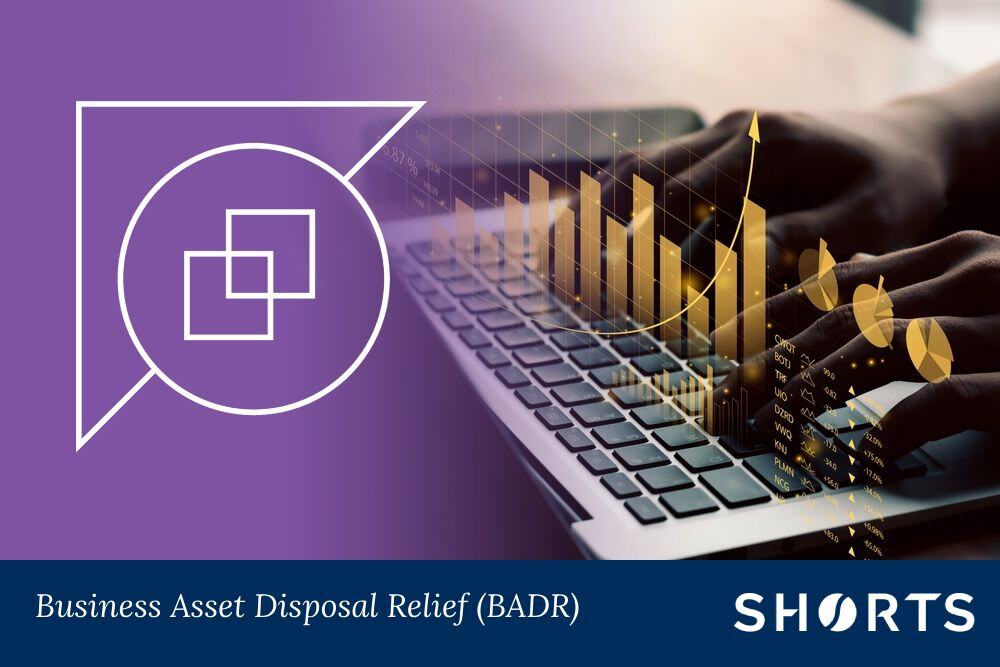
Business Asset Disposal Relief (abbreviated as BADR and sometimes known as “BAD Relief”) is a tax relief in the UK that reduces the rate of Capital Gains Tax (CGT) paid on the gains made when disposing of an interest in a business. The relief was introduced for individuals and trustees to encourage business investment.
Before 6 April 2020, BADR was known as “Entrepreneurs’ Relief”.
How does BADR work? At a glance
- Business Asset Disposal Relief (BADR) reduces the Capital Gains Tax rate on disposals of qualifying assets from 20% to 10%.
- There's a lifetime limit on the amount of capital gains that can benefit from BADR (see below for more information)
- BADR usually applies to the disposal of business assets, such as company shares or part of a trade operated by a sole trader or partnership.
- The individual must have owned the business for at least two years before the disposal.
Who can claim BADR?
Business Asset Disposal Relief is available to individuals who operate businesses and dispose of a part of their business. This could be:
- Business owners (individuals)
- Individuals in a partnership
- Shareholders with at least 5% of the shares and voting rights of the business
- Trustees may also claim BADR on the disposal of shares or assets, provided a qualifying beneficiary meets the necessary conditions.
Individuals must have owned the business or shares for at least two years before the disposal.
Companies cannot claim BADR.
What assets qualify for BADR?
Business Asset Disposal Relief (BADR) only applies to the disposal of certain business assets. These typically fall into one of the following:
- Shares in a company: Shares in a trading company, or holding company of a group of companies.
- Partnership interests: When someone invests in a partnership, they acquire an interest in all the assets used in the partnership. These assets, including goodwill, may be eligible for BADR if they are capital assets.
- Sole trader assets: The capital assets used in carrying on a trade or business as a sole trader, including machinery, vehicles, buildings and property.
There are further conditions around each type of disposal for them to qualify for BADR.
BADR will sometimes also be available on a separate disposal of assets used in one of the above types of business, if there has been a qualifying disposal of the type outlined above.
What is the lifetime limit for BADR?
The BADR lifetime limit is the maximum amount of gains on which you can claim Business Asset Disposal Relief during your lifetime.
- As of 2024/25, the lifetime limit or BADR is £1 million.
This means that throughout your life, you can apply the reduced 10% Capital Gains Tax rate to qualifying gains up to a total of £1 million.
Once you pass this £1 million limit, any further gains on which you might otherwise claim BADR will be taxed at the standard Capital Gains Tax rate (20%) instead.
What does it mean to “dispose” of an asset?
To dispose of an asset essentially means transfer ownership of the asset to someone else in any way. A disposal does not just mean the sale of the asset.
For example, you might give it away to a family member. You might exchange the asset for another asset, such as a property.
Disposing of an asset often triggers a capital gains tax event, meaning you may need to calculate any profit or loss from the disposal for tax purposes.
Is Business Asset Disposal Relief changing?
July 2024 saw the election of a new Labour government in the UK. While increases to income tax and National Insurance contributions have been ruled out, experts expect the new chancellor will need to raise taxes elsewhere as part of the upcoming October 2024 budget statement.
One area that has not yet been ruled out for potential change is Capital Gains Tax and BADR. In particular, the BADR allowance (lifetime limit) may be reviewed. The lifetime allowance is currently at its lowest level of £1m, the same as when introduced (by the last Labour government) in 2008.
How can you claim Business Asset Disposal Relief (BADR)?
You must claim BADR through your Self-Assessment tax return in the year you dispose of the asset. In the Capital Gains section of your tax return, you must provide details of the disposal, including the proceeds, purchase price, and any associated costs (such as legal fees). This will help you calculate the capital gain. When completing the relevant section, there is an option to claim BADR. You will need to select or indicate that you are claiming the relief on the qualifying gains.
The claim must be made by the first anniversary of 31 January following the tax year in which the disposal occurs.
It is essential that you maintain detailed records of the disposal, including proof of ownership, sale documents, and calculations. HMRC may require these to support your claim.
.jpg)
Brian Gooch
I work extensively in the corporate owner managed business sector, covering transactional taxes, property taxes including Stamp Duty Land Tax and VAT, and all areas of business tax planning. I have considerable experience in maximising tax efficiency by reviewing business structures and planning corporate reorganisations.
View my articlesTags: Business Taxes, Capital Gains Tax
